by Kristen Minogue
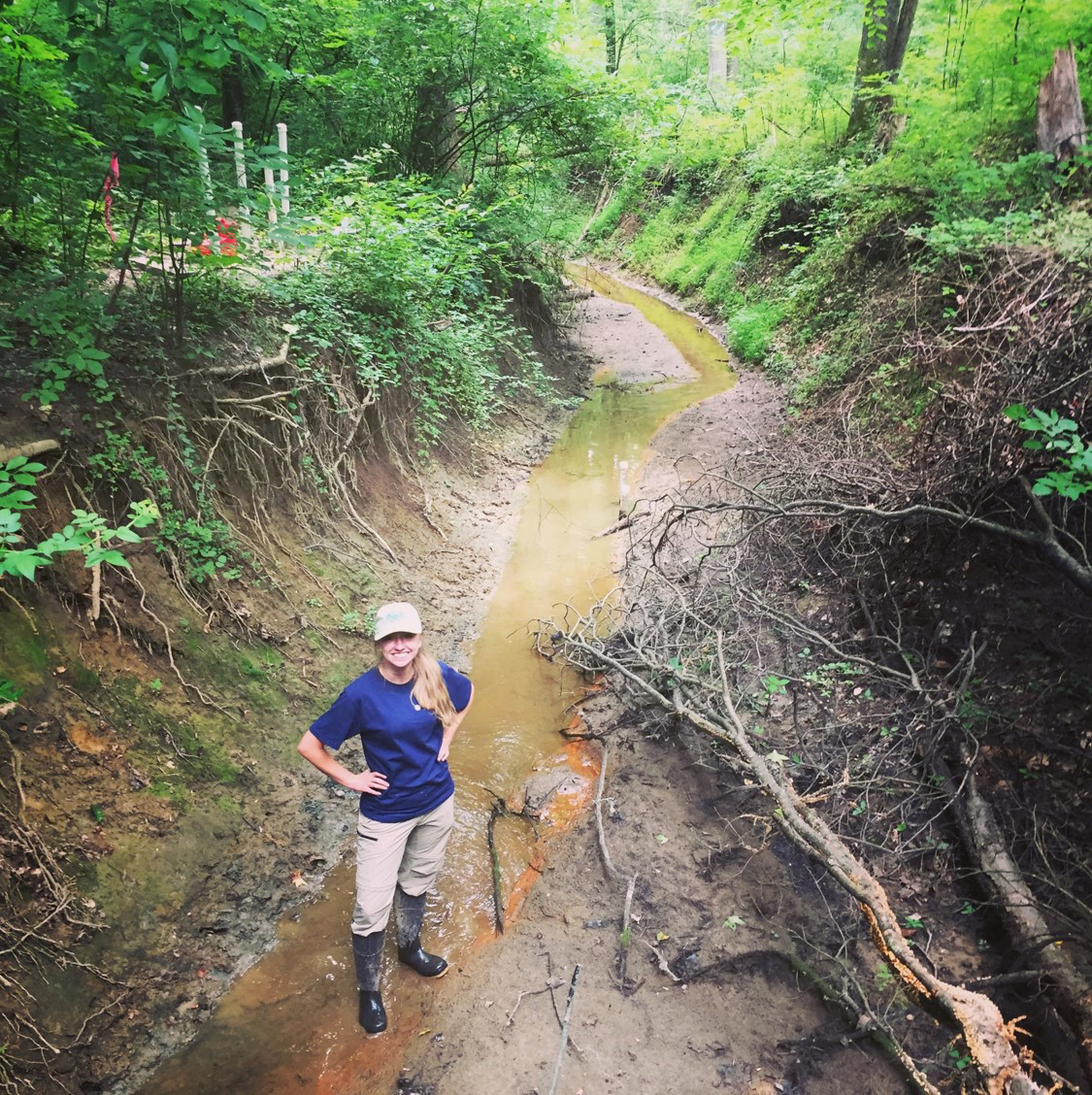
SERC Intern Julianne Rolf stands in the streambed of Muddy Creek. Erosion has caused it to drop 10 feet below its floodplain. (SERC)
In the forests of Edgewater, Md., a stream called Muddy Creek is sinking. By itself this is hardly news. The Chesapeake’s ailing streams span thousands of miles, and the watershed’s states have devoted hundreds of millions of dollars towards trying to restore them. It’s part of a gargantuan effort to clean up the Chesapeake. Sick streams create a sick bay, and environmental managers are anxious to stem the nutrient and sediment overload from streams. But for all the zeal surrounding stream restorations, their success rate hasn’t always lived up to the hype. How effective can they be—and what do they need to succeed?
Fortunately, this stream happens to be under the watch of scientists. And the restoration of Muddy Creek may yield some answers.
Raising the Depths
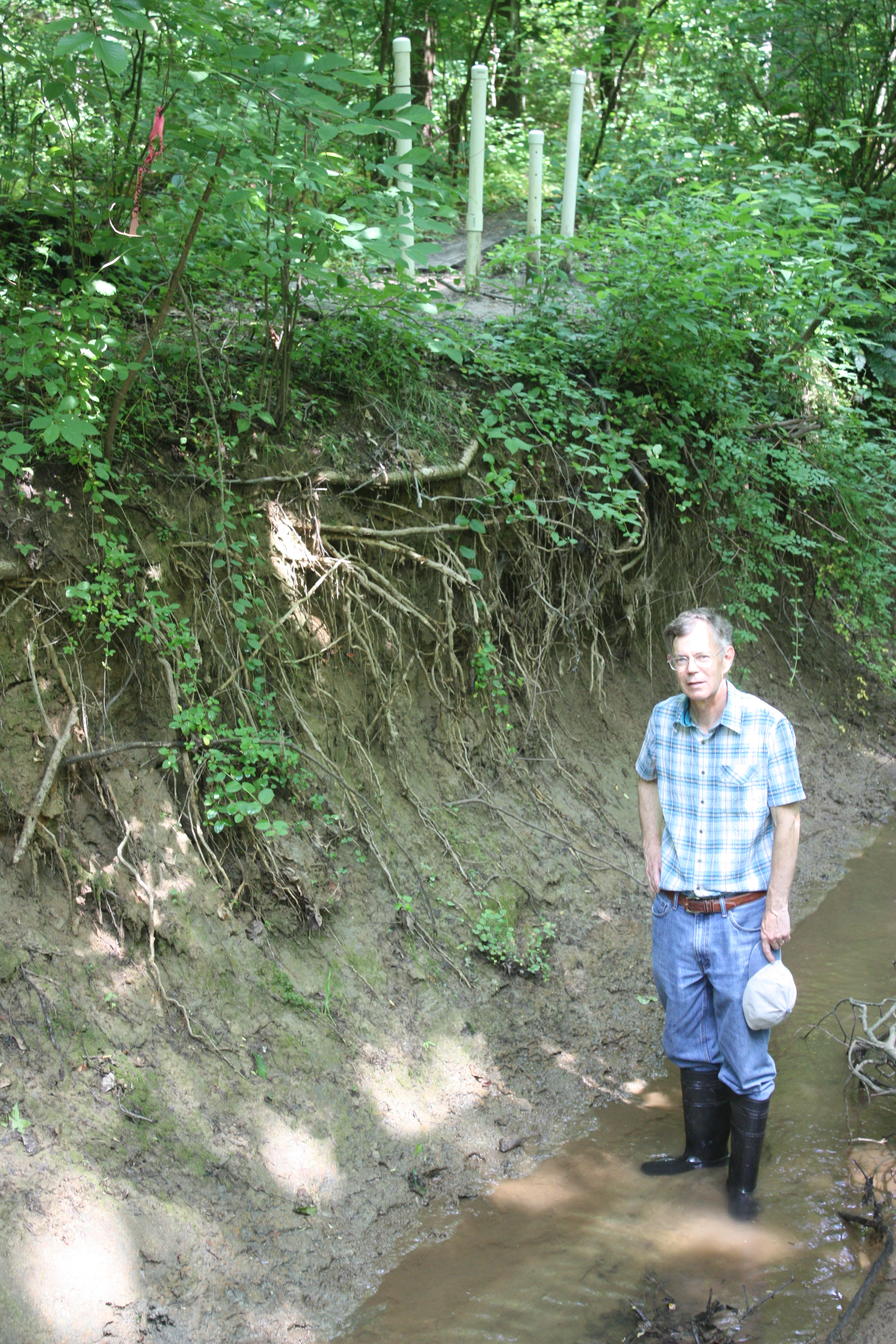
Tom Jordan in the Muddy Creek streambed. Above, white groundwater sampling wells extend from the bank. (SERC)
Muddy Creek flows through the back woods of the Smithsonian Environmental Research Center (SERC). Its steep banks drop 10 feet to the streambed below, the product of decades of erosion. This spells trouble whenever storms break. A shallower, healthier stream would flood over its banks, letting water soak into the adjacent floodplain.
“That’s why they call them floodplains,” explained Tom Jordan, SERC nutrient ecologist and a principal investigator on the project. Floodplains can also trap sediments and the phosphorus often attached to them. But because of Muddy Creek’s depth, it’s completely cut off from its floodplain. Instead, water tears through the stream during storms, carrying excess nutrients, sediments and other pollutants. The source of the problem is most likely the drainage tunnel beneath the nearby road, which narrows and accelerates the flow.
“It’s kind of like when you put your finger over a hosepipe and the water comes out quicker,” said Joshua Thompson, a postdoc studying the stream in Jordan’s lab. Thompson grew up near the source of the Hamble River in England. “Whenever it rained, I used to go out there to see the flow, because it was just such an awesome thing to look at,” he said. “I got excited about, what happens? Where does the water go when it rains?”
Right now, much of this stream’s water goes straight to the Bay. But Muddy Creek is on the verge of a relatively new kind of restoration, which will raise the streambed, restore its floodplain and—hopefully—slow it down.
The technique is called “regenerative stormwater conveyance.” It involves filling a 450-meter (1350-foot) branch of the stream with sand and wood chips to raise the water level, and using boulders to create miniature dams to slow the water and provide stability. The stream itself will run underground during restoration, inside a small pipe contractors will install at the very beginning. Once the sand and wood chips are set, they’ll remove the pipe and water will bubble up over the top.
“I can’t wait to see that,” Jordan said. “I’ve heard it’s pretty spectacular. First there’s just dirt and then, boom, there’s a stream.”
Restoration in Real Time
For Maryland, the study couldn’t have come at a more urgent time. The state needs answers. It has a federal mandate to slash nitrogen, phosphorus and sediments leaching into the Bay by 2025, since those are key culprits behind algal blooms and dead zones. The clock is ticking, and stream restorations are among the most popular solutions.
“People are passionate about Chesapeake Bay,” said Chris Patrick, a SERC research associate monitoring the stream’s aquatic life. “They want to fix it. They want to spend money to fix it.”
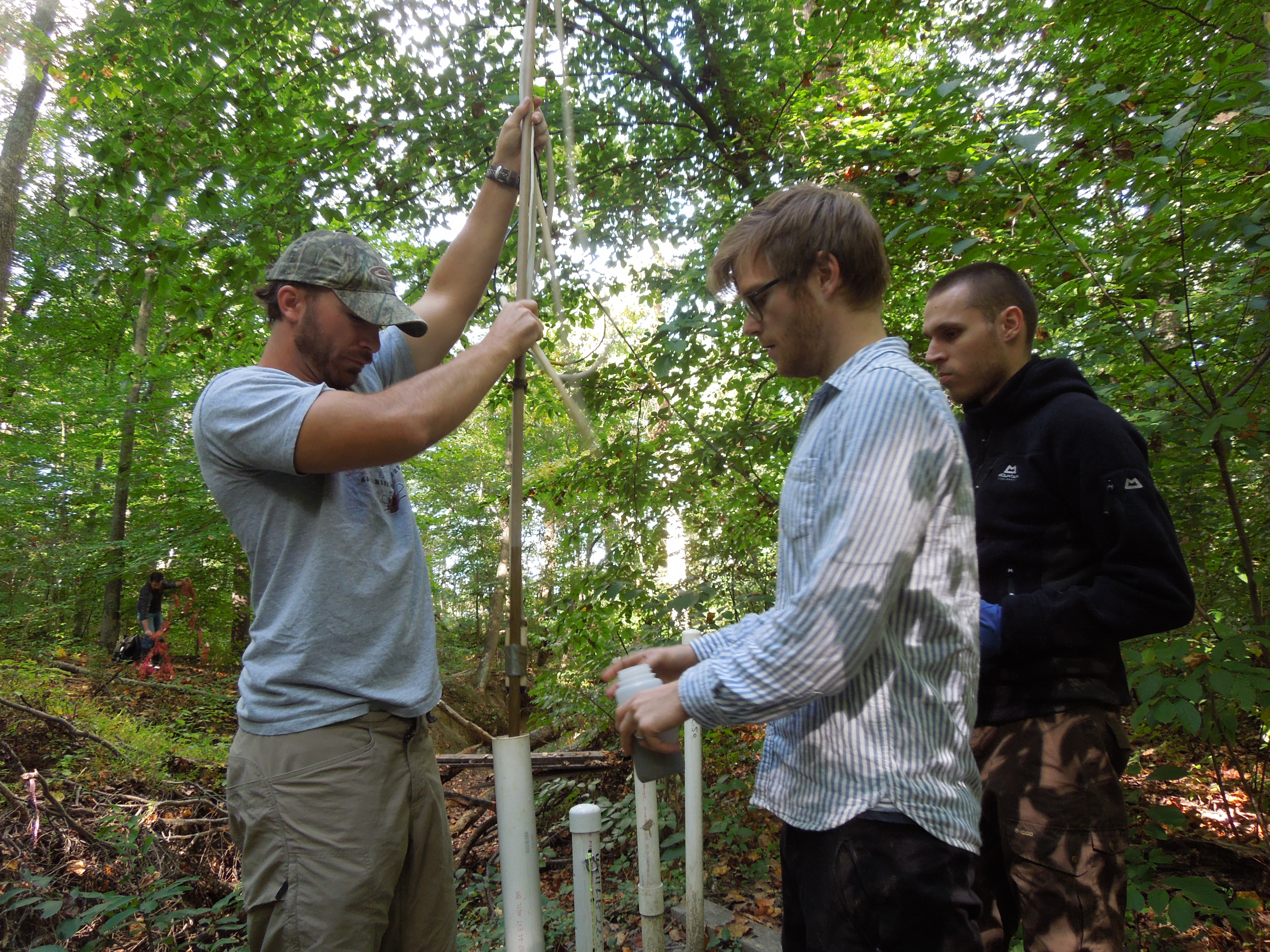
Left to right: Technician Max Ruehrmund, postdoc Joshua Thompson and intern Jan Kreibich take a water sample from one of the Muddy Creek piezometers. (SERC)
Right now data are mixed on how well restorations work and the best way to do them. A 2013 study found while restorations can change how streams flow, they don’t consistently remove nutrient pollution. Review papers examining dozens of other studies have found similar results: Many restorations aren’t that successful.
However, restoration is a difficult thing to measure, Jordan pointed out—especially when it comes to removing nutrients and sediments. Impacts of groundwater, multiple tributaries, and never-ending changes in stream flow make total nutrient removal a hard figure to pin down.
The Muddy Creek project may be the most thorough attempt to get a full picture. Scientists will track the stream before, during and after restoration. They’ll monitor how much nitrogen, phosphorus and sediment go into and out of the restored section, and compare it to an unrestored stream nearby. They’re doing a similar restoration at an urban stream behind Annapolis Harbor Center, with another control stream.
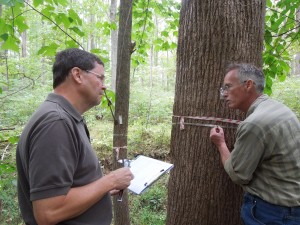
SERC technician Jay O’Neill (right) shows volunteer Steve Myers how to measure the width of a tulip poplar tree. The floodplain’s return could transform the forest as the soil becomes wetter. (SERC)
Jordan’s lab has already lined the Muddy Creek banks with white PVC pipes to sample groundwater nutrients. At both ends of the restoration, they’ve inserted instruments called sondes, electronic and optical sensors that take data on nutrients, acidity, oxygen and other water-quality indicators every 15 minutes. Other scientists, like Patrick, will investigate how the restoration impacts leaf decomposition, stream biodiversity and stream shape. They’re even monitoring the trees. Oaks and beeches, which prefer dry soil, have grown up around the eroded stream. Once the floodplain returns, those species may vanish, and wetter species like maple and spicebush may replace them.
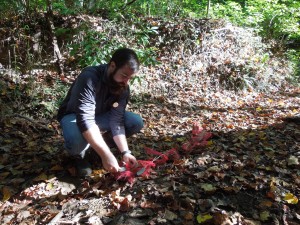
SERC research associate Chris Patrick lays out a mesh of leaf litter to measure decomposition. (SERC)
“This is a natural process,” says Jay O’Neill, a technician in SERC’s plant ecology lab which is tracking the trees. “These oaks and beeches, they’re here, but they weren’t part of the original, natural community.”
Jordan is especially interested in tracking the different speeds and energies of the stream. If restored streams struggle to remove nutrients most during high-energy storms, creating larger or stronger restorations might be the solution. But the answers are still waiting.
“You’re really taking a stream and pushing it in a direction that it doesn’t normally go all of a sudden,” Jordan said. “I don’t know what we’ll find.”
Funding for this project came from the Chesapeake Bay Trust, the Chesapeake Rivers Association, the Chesapeake and Atlantic and Coastal Bays Trust Fund, and restoration contractors Underwood & Associates. SERC retains publication rights for all data.


Would love to have a tour and follow the progress.
Chris
Watershed steward
We would love to have a tour of this site. We also have a very similar situation in one of our development plans in Prince George’s County. I am curious how you obtained the permits from ACOE and MDE?